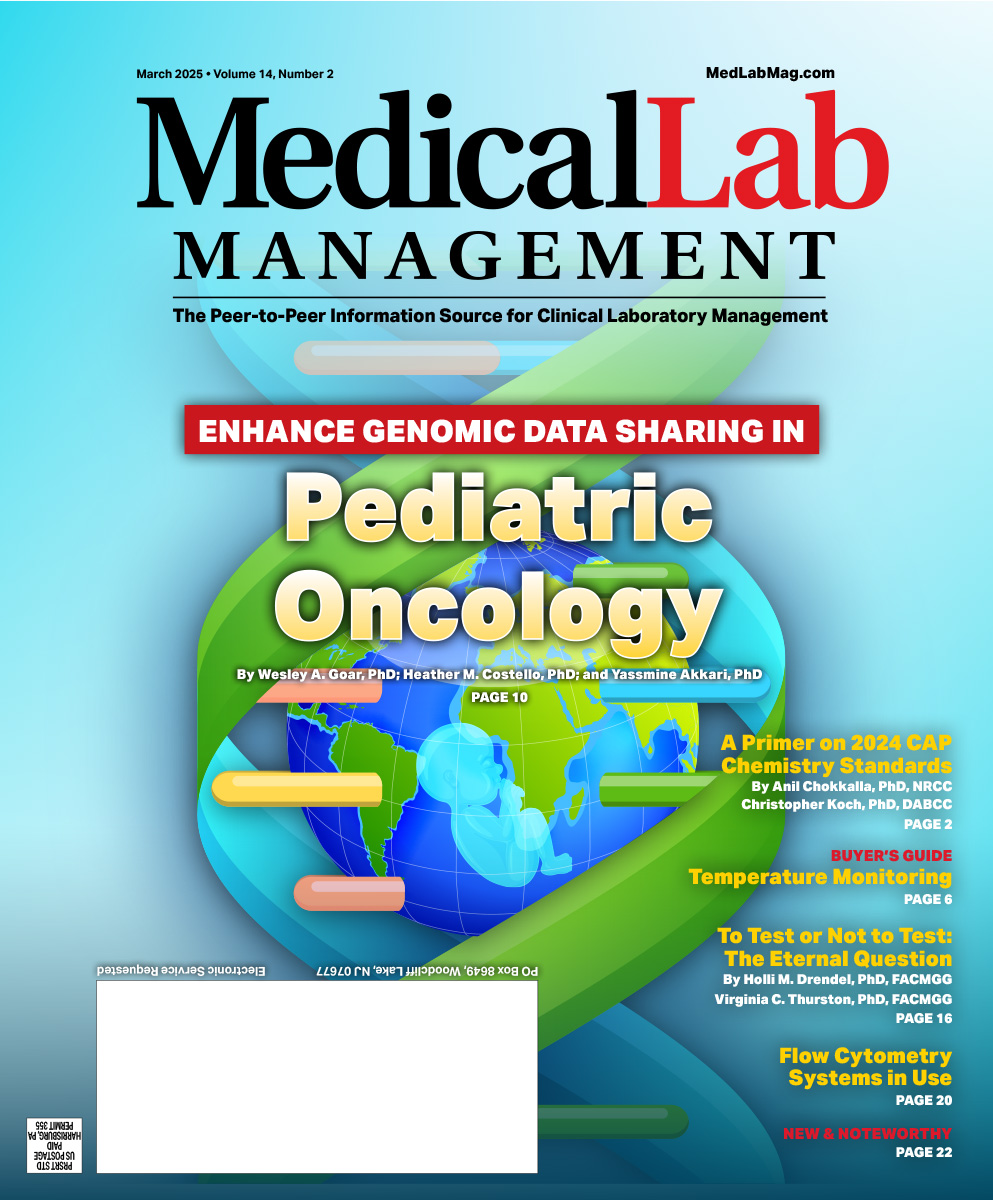- Show Menu
- Contact Us
- FAQs
- Reader Service
- Survey Data
- Survey Winners
- Testimonials
- Upcoming Events
- Webinars
Engineering Lab Workflow Changes to Support a New EHR
As technology advances, the need to upgrade or implement a new electronic health record (EHR) system is on the horizon for many clinics and hospitals nationwide. At Mayo Clinic, an EHR upgrade occurred over a three-year time frame encompassing all locations; from small critical access hospitals and moderately sized hospitals and clinics in Minnesota and Wisconsin, to the large destination medical centers in Arizona, Florida, and Minnesota. Considerations all medical sites nationwide are either facing today or will face sometime in the future are: the scope of an EHR upgrade, how laboratory information systems (LIS) fit into the integration process, and how laboratory patients’ needs will be met.
Mayo Clinic has successfully integrated disparate LIS in the past. However, due to the short timeline and necessary convergence of a system-wide EHR implementation strategy, information system integration across the entire enterprise raised additional complexities for specific clinical discipline information systems (the LIS among them). Of note, particular challenges arise when various sites within a health system do not work with the same LIS or EHR system. When individual laboratory sites are not related from the perspectives of system, process, and governance, a careful approach is necessary to maximize the positive impact of an EHR integration with the current LIS. Leadership encouragement and staff engagement stemming from the executive level are also critical for a successful information system change and implementation.
Mayo Clinic was able to utilize heath system engineers from an internal department called Management Engineering and Internal Consulting (ME&IC) to guide the lab workflow change process when integrating the new EHR. The guidance of the engineers, coupled with the insight and input of individual laboratory directors and management, set the total supporting framework for keeping the institutional vision of placing the needs of the patient first.
Identify a Lab Champion for LIS Change
The role of a laboratory champion is to provide guidance, support, and resolution by bridging any identified gaps with laboratory staff, non-laboratory clinical staff, and upper management. A successful champion will align both laboratory and clinical objectives, maintain the administrative vision, support change management, and effect decision making while also communicating with the facility’s leadership (see FIGURE 1).
ME&IC’s health system engineers facilitated the process of identifying a lab champion for each staggered EHR go-live and remained engaged with these champions throughout the three-year project period. The health system engineers assigned to work with the individual laboratory leaders were chosen in part due to past experience working in and with clinical laboratories, yet as engineers, they were able to remain unbiased when it came to the overall Mayo Clinic system needs. Accordingly, the engineers and the lab champions were able to successfully focus on the following directives:
- Emphasize efficient convergence
- Provide enterprise leadership
- Share best practices
- Dissolve false assumptions
- Facilitate a neutral, mutually beneficial clinical environment
Difficult decision making and clinical challenges are common occurrences when tackling a large-scale operational change. These tend to create barriers during any implementation; thus, leadership support is critical throughout the EHR conversion.
Consider the example of Mayo Clinic’s experience operating different blood bank LIS modules across state lines. This challenge brought forward topics including: state regulations considerations, site testing methodology decisions, and process convergence. Leadership was leveraged by including them in strategy and design sessions, which resulted in the creation of various weekly integrated work groups. Involving a lab champion from the beginning allowed for a successful execution, and resolution of the five directives above.
Start with an Engagement Process
When considering how the laboratory will integrate with a new EHR, the first question often is, “how does my LIS fit into the scope of the EHR strategy?” Do not assume those in charge of the EHR conversion have appropriately incorporated the needs of the laboratory based on the results of the discovery phase analysis alone. Often, large-scale computer hardware and software installations start with broad education for all parties involved concerning new functionalities, but this education may lack fine details and subtle impacts for specific clinical disciplines. Thus, the ME&IC heath systems engineer/lab champion relationship played a vital role in assessing the future lab integration in the discovery phase via engagement kickoff meetings, and made all parties’ needs known. Establishing the following steps and identifying phases were key to this process:
- Key roles and responsibilities
- Intended project deliverables
- Project execution team
- Capture current state workflows
- Converge on future state workflows
- Provide the tools and methodologies necessary to map out the lab’s future use of the new EHR
- Facilitate end-to-end program management tasks
- Develop preparation strategies for the RUN org once all of the sites are implemented (Note: A “RUN Organization” is a term meant to signify how an organization manages the EHR after implementation. This includes technical support, clinical focus area, pathway/communication for needed changes, and an overall structure to ensure long term efficiency/standardization.)
Given the constant daily challenges faced by lab leaders, their full engagement and collaboration during the discovery process and subsequent steps is critical. An extra level of complexity may exist if the laboratory needs to consider whether to keep its existing legacy LIS versus implementing the laboratory module that is part of the new EHR.
Engineering the Lab Workflow Change Process
Once the lab champion is established and engaged in the project, creating a Laboratory Program Core Team will serve to oversee progress and decision making during the changeover. This team can process requests and input from lab staff to optimize the lab information management structure and properly analyze current-state and future-state workflows from the onset. This defined structure (lab champion and engaged lab core team) also will help facilitate downstream approvals and decision-making opportunities in a timely fashion. Depending on the size and scope of your EHR/LIS change, input or establishment of the following resources and roles could prove essential, or at the least, beneficial to project success:
- Laboratory project management (PM) and business analyst (BA) resources
- Laboratory subject matter expert (SMEs)
- Non-laboratory clinical experts (eg, providers and nurses), administrative operations staff, laboratory information technology (IT) support staff, and vendor application support staff
- An enterprise laboratory leadership oversight group (for multi-lab-site facilities)
Current State Workflow Analysis
For laboratory directors, working with health system engineers should be a collaborative effort in defining what works well currently, and how best to move forward with the new system. It is essential that both parties understand the infrastructure of each laboratory sub-section when mapping the current state workflows. To this end, ME&IC health system engineers provided expertise in the following areas intended to benefit the laboratory experience:
- Facilitate and identify common scenarios/workflows that are heavily impacted by an EHR implementation via end-user collaborative build sessions
- Gather input from frontline staff (end-to-end workflow components) and explain system options and limitations
- Identify challenges or gaps in current workflow mapping from a systems perspective via collaborative build sessions
- Identify and clarify the functional specifications necessary for the laboratories to operate properly and beneficially post-implementation
- Solicit future wish-list enhancements and remain cognizant of their applicability
- Review findings and provide future-state workflow recommendations in collaboration with lab leadership, end users, and the lab program core team
Future State Workflow Analysis
Once the current state processes are mapped out, a health system engineer can take this information and identify best practice recommendations with the lab SMEs. Since each clinic or hospital may have different best practices or regional lab priorities, the engineer(s) can compile an enterprise inventory assessment and share insight with the various laboratory teams when proposing future-state workflows. As such, engineers can provide expertise in the following areas of this process:
- Evaluate data provided by the enterprise
- Incorporate unique regional lab practices
- Eliminate redundancy and duplication in systematic operations
- Encourage systems convergence and determine viability
- Incorporate the impact of roles being lost or re-absorbed within the lab based on change
- Engage leadership throughout the future-state development process with progress updates
- Provide and adhere to the deadlines set by the overall project team
One area of future state workflow refinement focused on streamlining Mayo Clinic’s Enterprise lab test menu during EHR implementation. As one example, Mayo Clinic offered over 50 variations of a single test across sites. By analyzing the data and mutually determining the best options, our lab teams were able to converge to a standardized list of ten. The ability to eliminate redundancy and duplication within the lab test menu offered at various Mayo Clinic sites was success.
The future state workflow analysis also allowed for laboratories to incorporate wish list enhancements or optimizations. Several specialty labs desired less paper and more electronic means of capturing various specimen details (eg, pathology and genetic specimens). The following are a few examples of electronically captured specimen information that previously were handwritten: collector initials, phone numbers, pager numbers, source and site, among others.
Change Management Strategies
In the interest of helping the laboratory adjust to a new EHR/LIS, health system engineers should provide the strategy and change management tools necessary to educate and allow for a smooth transition at each go-live stage. This strategy gives the laboratory time to prepare for the changes ahead and the systems training necessary to align their operations prior to go-live. Lab leadership is also enabled to analyze staff engagement in real time and given opportunities to address any discrepancies or recognize staff achievements toward the overall LIS/EHR implementation strategy.
To better prepare for the unknown, during the Mayo Clinic new EHR implementation, the system-engineer approach was to establish a Site Readiness Owner (SRO) team. This group engaged laboratory staff from each of the following areas: Laboratory program core team, administrative team, operations team, and director and manager staff. The SRO’s primary charge is to assist in the development and facilitation of communication tools, organize workflow impact discussion sessions, and perform and provide training resources for lab staff.
From beginning to end, having gained support from leadership and an assigned lab champion from each site, the integration of the current LIS with the new EHR was a successful endeavor. Most importantly, the project was completed while upholding the overarching Mayo Clinic vision, “the needs of the patient come first.”
Conclusion
As health care information technology continues to evolve and advance in scope and options, here are some brief lessons learned from the Mayo Clinic health system engineering point of view that you may be able to apply to your own experience:
- Health systems engineers were certified in various modules of the vended EHR application to provide an additional layer of expertise and knowledge to our clinical partners
- When converging elements, exercise careful control and move in small steps
- Encourage pilots and pilot audits
- Allow for project change and re-evaluate when necessary, particularly when expecting change in others
- Encourage staff involvement and share best practices with supporting documentation
- A large project “takes a village” to be successful. Create and maintain strong working relationships with laboratory and clinical providers for a successful future.
The strategic partnership with health system engineers for an EHR change or implementation is an excellent way to ensure laboratories are ready to take on the vital tasks of delivering streamlined, effective, and successful operations integrated into a new EHR system.
 Nicole K. Hanf, MA, is a senior health systems engineer in the Department of Management Engineering & Internal Consulting at Mayo Clinic in Rochester, Minnesota. Prior to joining ME&IC, Nicole provided laboratory test development support, workflow design, and IT consulting services to over 50 internal labs in her role as a senior application specialist in the Department of Laboratory Medicine and Pathology (DLMP) at Mayo Clinic.
Nicole K. Hanf, MA, is a senior health systems engineer in the Department of Management Engineering & Internal Consulting at Mayo Clinic in Rochester, Minnesota. Prior to joining ME&IC, Nicole provided laboratory test development support, workflow design, and IT consulting services to over 50 internal labs in her role as a senior application specialist in the Department of Laboratory Medicine and Pathology (DLMP) at Mayo Clinic.
 Aaron J. Stelpflug, MA, C(ASCP)CM, is a health systems engineer in the ME&IC department at Mayo Clinic. He began his career as a clinical laboratory technologist in biochemical genetics and cardiovascular laboratory medicine. After years of clinical, technical, quality, and IT involvement, Aaron transitioned to a quality specialist role within DLMP.
Aaron J. Stelpflug, MA, C(ASCP)CM, is a health systems engineer in the ME&IC department at Mayo Clinic. He began his career as a clinical laboratory technologist in biochemical genetics and cardiovascular laboratory medicine. After years of clinical, technical, quality, and IT involvement, Aaron transitioned to a quality specialist role within DLMP.
Like what you've read? Please log in or create a free account to enjoy more of what www.medlabmag.com has to offer.









